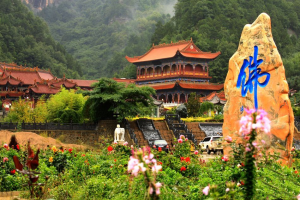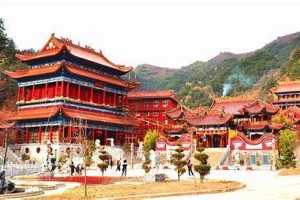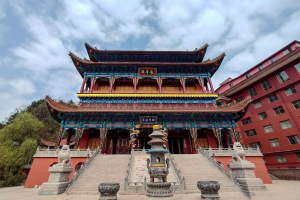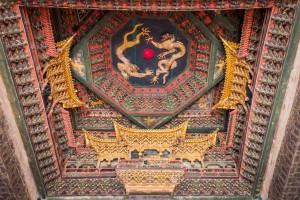Historical Backgroud
 The Jingtu Tenple
The Jingtu Tenple
The Jingtu Temple was to have been constructed by three different emperors during their respective reigns. Initially built by Li Siyuan, the Emperor of the Tang Dynasty, it served as his ancestral temple. In 1123, following the conquest of the Liao Kingdom by Emperor Wanyansheng, his mother found the monk Shanxiang to build it because the emperor believed in the Amitabha. Subsequently, in 1184, the temple underwent a reconstruction during the rule of Emperor Wanyan Yong, marking the completion of the Pure Land temple. Most of the Jingtu Temple was destroyed in 1969. Since the 1980s, it has been restored and expanded by various parties, forming a grand complex of three Buddhist temples. Over the past few years, the expansion of the site by adding new constructions such as Luohan Hall, Zangsuk Pavilion, and Jingmen Arch has significantly increased its scale.
Overall Red Tone:
The main building hall of Jingtu Temple is all in safranine as the key color, safranine walls, safranine beams and columns, red ochre glass, supplemented by a small area of color or bright wood carving, painting, white stone steps, fences, parapet linger among them, creating the main body of the temple to create an atmospheric, solemn, peaceful Buddhist cultural atmosphere and characteristics. The mystery of Buddhism is also on display.

Stone Lion:
The stone lions in the Jingtu Temple are numerous and varied in form. Especially the two stone lions in front of the archway buildings, are different from the stone lions in traditional Chinese temple buildings, so the hair is replaced by a spiral of hair, showing a naive expression. This pair of stone lions' hair flying in the wind, prominent muscle lines, and personality is extremely publicized, very the style of the king of beasts, but also shows the taste and spirit of Western carving art. There was a young lion on the back of the lioness, and the little creature raised its round bottom and bent forward, lest it should fall from its mother.

Zaojing (A decorative structure in traditional Chinese architecture):
The Zaojing at the top of the main hall covers all the ceilings of the three temples and is separated by the beam into nine palaces, that is, nine Zaojings. The Zaojing in the center of the hall is the core of the entire ceiling, and it is also the essence of the dome. The center of the Zaojing is a red sphere, and two embossed golden dragons swim around it, and the two dragons play with pearls. The outer frame is octagonal, from top to bottom, countless brackets in accordance with each side of the oblique wall, layer upon layer, surrounding a variety of shapes (positive four sides, oblique four sides) of the frame, the structure of a changing Zaojing. Compared with the central Zaojing, the other eight caissons are shallower in depth, less complex, and more distinct. The rest of the Zaojing or quadrilateral, hexagonal, or octagonal, and the central Zaojing of the Golden Palace pavilion and the golden carving dragon is different, between the two central Zaojing only with gold arch, carving dragons is also made of gold relief. The rest of the Zaojings do not use gold.

Features
Location: Southeast of Tianshui City, Xianren Cliff Houchuan
Scenic Spot Level: National 4A Level Scenic Spot
Chinese Name: 净土寺
Time Needed: 3 hours
Travel Information
Opening Time: 24/7
Ticket Price: 15CNY
Service Number: 0938-6811864
Best Time for Visit: September - December
Travel Tips
Jingtu Temple is a Buddhist temple, visitors should respect the Buddhist faith when visiting, keep a quiet, solemn attitude, do not make loud noise, play and play. At the same time, do not touch Buddhist statues, Buddhist artifacts and other religious items, so as not to cause disrespect to the temple.
When visiting the temple, pay attention to your personal safety and do not climb high places or near dangerous areas. At the same time, pay attention to take good care of personal belongings to prevent loss.




































